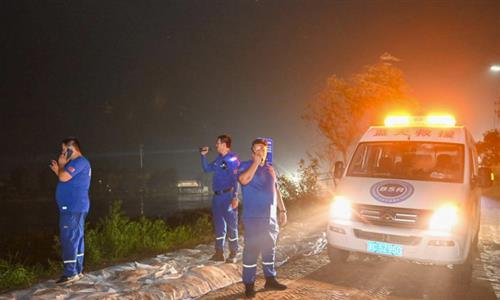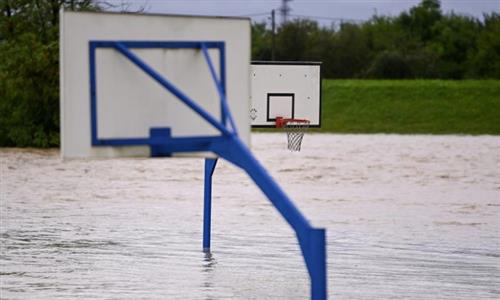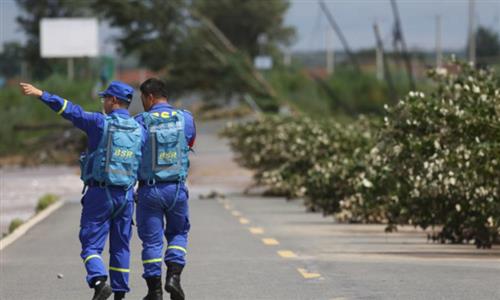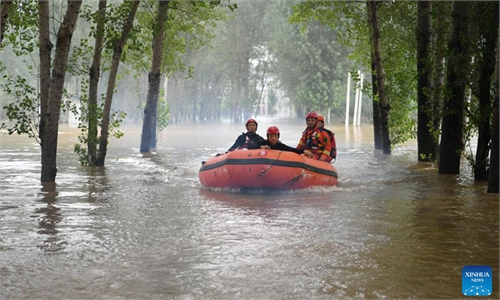Rescue work pouring in to help flood-damaged Northeast, North China
Western media hype tries to sow discord between govt and public: experts
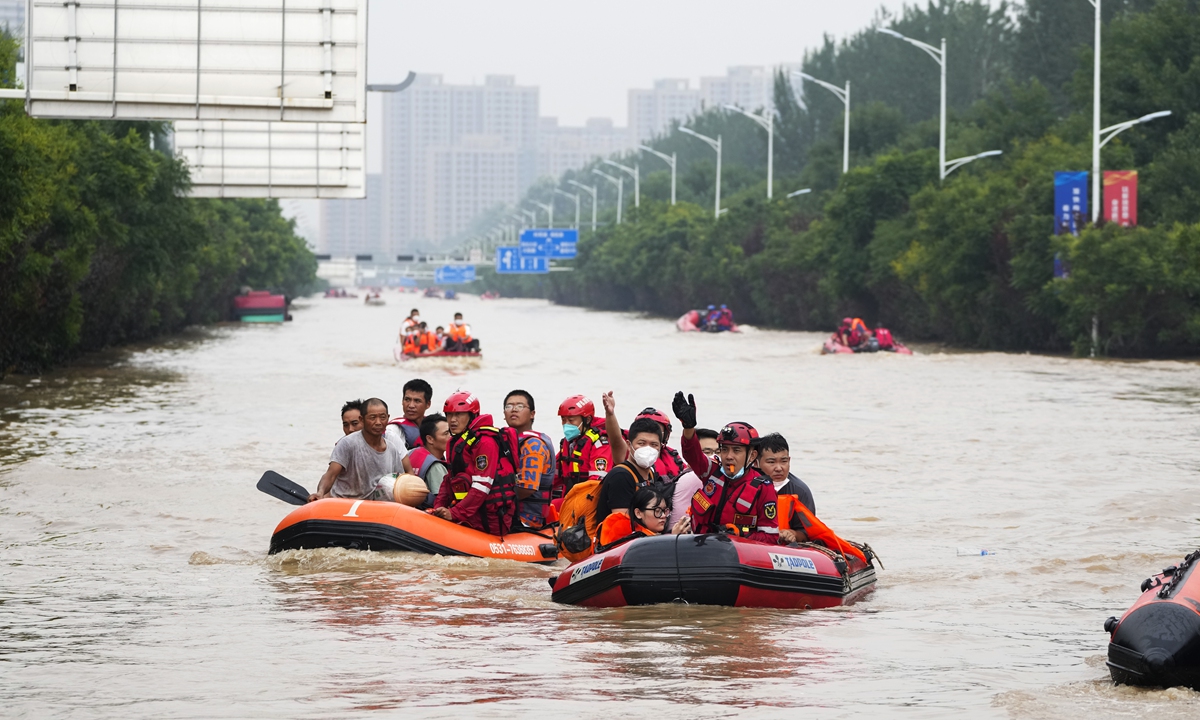
Residents evacuate on rubber boats through floodwaters in Zhuozhou in northern China's Hebei Province, south of Beijing on August 2, 2023. Rescue teams continued their work on Wednesday in Zhuozhou to extract people trapped in houses by floodwaters after days of downpours brought by Typhoon Doksuri. Photo:VCG
China raised its flood-control emergency response in the country's northeastern regions to Level III on Sunday morning following severe rainstorms and flooding in North China's Inner Mongolia Autonomous Region and Northeast China's Heilongjiang and Jilin provinces, as torrential rain caused by the remnants of Typhoon Doksuri cost six lives in Jilin's Shulan city and inundated large swaths of grain fields.
Meanwhile, the lives of residents in parts of Beijing and Zhuozhou, Hebei Province, where heavy rainfall and floods last week wreaked havoc, are starting to return to normal. Zhuozhou is about 60 kilometers to the south of downtown Beijing.
Top-down coordination and nationwide unity have been formed ever since Northern China and Northeast China were hit by the rare deluge, including the central government's timely guidance and allotment to help affected people, the military racing against time to evacuate and relocate people and transport emergency supplies and civilian rescue teams pouring into flood zones to save lives and property. Experts said the efforts provided a strong rebuttal to the Western media's attempts to use the floods to sew discord between the Chinese public and the government and to smear the Chinese government's flood control efforts.
For days, heavy rain has swamped Heilongjiang, Jilin and Inner Mongolia, resulting in floods in some rivers in those regions. As of 8 am on Saturday, 25 rivers, including the Lalin River and Mudan River, both cover Jilin and Heilongjiang, had exceeded water warning levels by 0.06-3.40 meters, with five rivers exceeding the guaranteed water level, China's Ministry of Water Resources said on Sunday.
The floods resulted in the loss of six lives and the disappearance of four people in Shulan city, Northeast China's Jilin Province. All the missing people are public officials who were engaged in emergency rescue and disaster relief operations, local authorities confirmed on Sunday.
Shangzhi city in Heilongjiang, an agricultural city, has recorded the biggest rainfall since 1957, and the city has suspended classes, production and transportation since August 2, local media reported. Wuchang in Heilongjiang, well-known for its high-quality rice, reported that large swaths of rice paddies were inundated. More than 40,000 people in Wuchang were relocated as of Sunday afternoon.
Local authorities, fire brigades, armed police forces and other rescue forces have been working throughout to save lives. Around 1,000 soldiers from a brigade of the Northern Theater Command of the Chinese People's Liberation Army (PLA) joined the rescue work in Jilin, using drones to help.
Meteorologists told the Global Times on Sunday that the downpour in Northeast China was triggered by the remnants of Typhoon Doksuri, which also wreaked havoc in North China last week. The recent heavy rainfall process in Northeast China has the direct participation of cold air, thus compared with the heavy rain in North China a few days ago, convection is more significant, said Ma Xunkuan, an expert from the National Climate Center.
North China's Tianjin Municipality issued a red alert on Sunday, the highest level of warning, for possible floods in its Daqinghe River, a major tributary of the Haihe River, which is currently undergoing its worst flooding since 1963, said local authorities.
The Daqinghe River saw its floods reach the range of Tianjin at noon on Aug 4 when the city had already put the river's significant floodwater detention and retention area into use.
After being hit by record floods last week, authorities in Zhuozhou in Hebei said on Sunday that residents' lives are returning to normal, as infrastructure, electricity and communication are being gradually repaired. It said that the flood peak has already passed, now Zhuozhou is clearing out all the water and preparing for secondary disasters.
Mentougou district in Beijing's western suburb, which was hardest-hit during the capital city's record rain, has relocated 5,561 residents as of Saturday noon. Some bus lines have restarted in Mentougou, Beijing media reported.
All-out effort
An article published by the Xinhua News Agency on Saturday said that when heavy rain hit North China, Chinese President Xi Jinping attached great importance to the situation. On August 1, he demanded all-out search and rescue efforts to find people missing or trapped in floods and geological disasters in an instruction issued on work concerning flood prevention and disaster relief.
In early July, he also demanded that authorities at all levels must give top priority to ensuring people's safety and property, and strive to minimize losses in the work regarding flood prevention and disaster relief.
Chinese authorities on Sunday earmarked an additional 350 million yuan ($50 million) to assist flood-hit regions of Beijing, Tianjin, Hebei and other provincial regions in Northeast China.
So far, the Chinese central government has allocated 520 million yuan in central natural disaster relief funds to those regions, according to the Ministry of Finance and the Ministry of Emergency Management.
The quick recovery of North China from record flood and rapid mobilization of rescue forces in Northeast China have once again demonstrated the "China speed" and the top-down efforts from the Chinese government to its public in fighting natural disasters, said experts.
China's top three energy industry giants - China Petrochemical Corporation, China National Petroleum Corporation and China National Offshore Oil Corporation - have ramped up energy supplies to flood-hit Zhuozhou to help local rescue work.
Attendants on K1178, a train bound from Beijing to Yinchuan in Northwest China's Ningxia Hui Autonomous Region which was stranded for some 70 hours in Beijing's Yancheng Railway Station due to heavy rain in North China were awarded 10,000 yuan each for successfully relocating all 841 passengers, railway authorities revealed on Sunday.
In the flooded village of Huangjiajie, Matou township, Zhuozhou city, Party secretary Luo Jian told Global Times reporters on Saturday of his relief when rescuers arrived.
"When I saw the rescue teams arrive, tears welled up in my eyes. They brought us hope and courage to conquer the disaster," Luo said.
Flooding is much more common in South China, so these extreme flood events should be regarded as a wake-up call for China's northern regions for the need to prepare for more frequent floods in the future, as climate change has been exacerbated in recent years, Jia Weilie, deputy head of Beijing Academy of Ecocivilization, told the Global Times on Sunday.
West's hyping
After Zhuozhou was flooded, coming on the heels of Beijing being hit by heavy rain, Western media began torrents of hype that "officials made sure floodwater went elsewhere" to safeguard Beijing, as per The New York Times.
Cheng Xiaotao, deputy chief engineer of the China Institute of Water Resources and Hydropower Research, slammed the speculation as being inaccurate, since the adoption of flood storage areas is an overall consideration.
Generally speaking, the effectiveness of flood detention areas is more relevant to downstream areas rather than upstream areas, said Chen, noting that since Beijing is located in the upstream area, the use of the flood detention areas benefits other nearby cities more.
However, for some places which have never been used as or planned to be used as flood detention areas, such as Zhuozhou, they can suffer from severe waterlogging due to a lack of experience in coping with emergencies, Ma Jun, director of the Beijing-based Institute of Public and Environmental Affairs, told the Global Times on Sunday.
Jia also slammed the Western media's accusations as deliberately misguiding. He said that the central government attached great importance to flood prevention and the protection of people's lives. "No matter where the people reside, Beijing or Hebei, they are on Chinese territory and under the government's protection. We treat all our people equally," Jia said.
Experts called the Western media's hype, as usual, as trying to sow discord between Chinese people and the government.
